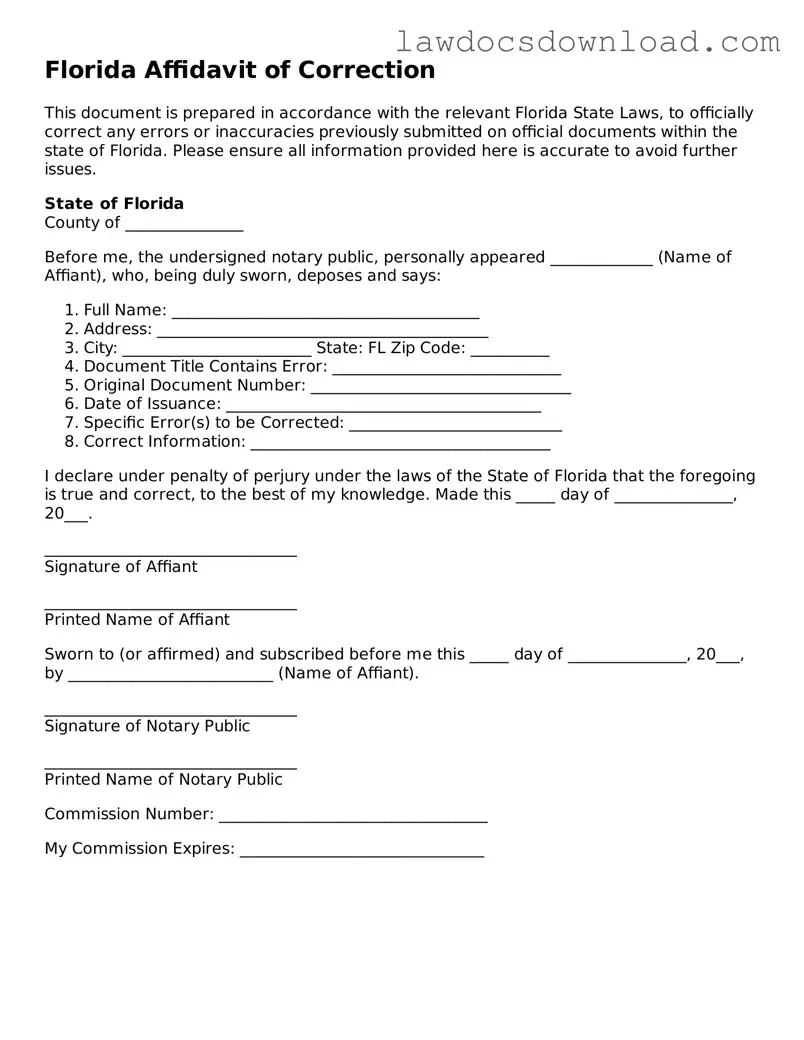The Florida Affidavit of Correction shares similarities with the Affidavit of Heirship. This document is often used to establish ownership of property when a loved one dies without leaving a will. Both documents are sworn statements, requiring the signer to attest that the information provided is true to the best of their knowledge. While the Affidavit of Correction corrects information on official documents, the Affidavit of Heirship identifies rightful heirs to a decedent's assets, serving to clarify and correct ownership records.
Similarly, the Amendatory Endorsement is another document that parallels the Florida Affidavit of Correction. Employed primarily in the insurance industry, an Amendatory Endorsement modifies the terms of an insurance policy. Like the Affidavit of Correction, it serves to correct or amend previously stated information, ensuring policies remain accurate and up to date. Both documents function as formal mechanisms to rectify inaccuracies, although they operate in different contexts.
The Correction Deed is a real estate document that rectifies errors in previously recorded deeds. Errors such as misspelled names, incorrect property descriptions, or wrong lot numbers can be amended through this deed. The Correction Deed and the Florida Affidavit of Correction are similar in that both correct documents of significant importance. However, the Correction Deed specifically addresses errors in property-related documents, affirming the correct information on public record.
Vehicle Title Correction Forms are used to correct information on vehicle titles, such as misspellings or inaccurate vehicle identification numbers. Like the Florida Affidavit of Correction, these forms ensure that vehicle titles reflect accurate and current information. Both are critical for the legal operation and ownership of vehicles, facilitating the correction of vital documents to avoid future disputes or issues in ownership verification.
The Bill of Sale Correction Form is another document closely related to the Florida Affidavit of Correction. It is used to correct errors in a Bill of Sale, a document that records the sale of goods, showing the transfer of ownership from seller to buyer. Both forms ensure accurate historical documentation of transactions and ownership, though the Bill of Sale Correction Form specifically addresses sales transactions.
An Errata Sheet, used in legal and publishing contexts, serves to correct errors in printed materials after publication. Like the Affidavit of Correction, it officially acknowledges and rectifies inaccuracies. However, while the Affidavit of Correction is used for legal documents, the Errata Sheet is typically used for books, academic papers, or legal filings, ensuring that readers have the most accurate and updated information.
The Name Affidavit is another document bearing resemblance to the Florida Affidavit of Correction, particularly used when an individual’s name appears differently across various documents. It serves to declare that different name variations refer to the same person. Both documents are valuable for clarifying discrepancies in official records, though the Name Affidavit specifically focuses on reconciling different representations of a person’s name.
Lastly, the Vital Record Correction Form, used to amend birth certificates, marriage certificates, and death records, is akin to the Florida Affidavit of Correction in purpose. Such corrections might involve misspellings, incorrect dates, or other factual inaccuracies on vital records. Both these forms play a critical role in confirming the accuracy of personal and legal documents, ensuring that such records faithfully represent the truth.
